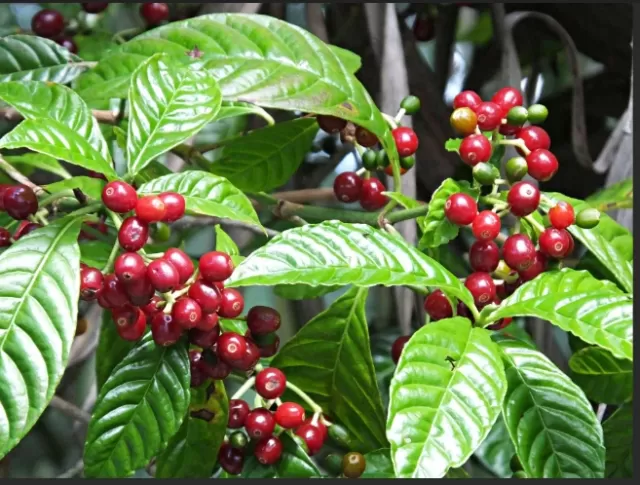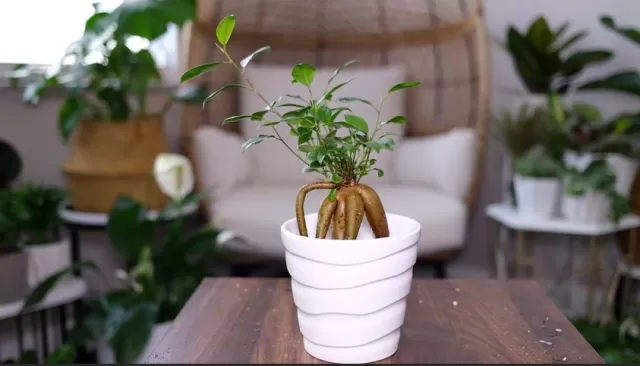Growing and Caring for Fragrant Coffee Plants Indoors. Green Elegance: Embracing the Lush Beauty of the Coffee Plant. The coffee plant (Coffea arabica) emerges as a tropical evergreen shrub, gracing your home or garden with glossy leaves that exude a vibrant and lush green ambiance. While it demands a bit of patience, the plant eventually unveils fragrant, white flowers, a testament to its natural beauty. These blossoms, in turn, give birth to coffee cherries, each housing seeds that, in the hands of skilled coffee farmers, transform into the beloved coffee beans.
Remarkably resilient, the coffee plant, when nurtured with care, can thrive for upwards of 60 years, becoming a long-lasting companion in your botanical haven. In its native tropical habitat, coffee plants flourish outdoors, but they also seamlessly transition into becoming captivating houseplants, bringing a touch of the exotic into your living space. The coffee plant doesn’t just promise the potential for a delicious cup of coffee; it also offers an enduring source of visual delight, whether as a garden gem or an elegant addition to your indoor sanctuary.
Growing Coffee Plants Outdoors: A Guide for Zones 10 to 11

For those fortunate enough to reside in zones 10 to 11, cultivating coffee plants outdoors can be a rewarding venture.
Linda Langelo, a horticulture specialist at Colorado State University, provides valuable insights into this process, ensuring that your coffee plants thrive in environments with daytime temperatures of 70 to 80 degrees Fahrenheit and nighttime temperatures of 60 to 65 degrees Fahrenheit.
Here’s A Step-By-Step guide to growing coffee plants outdoors:.
Choose the Right Location: Select a spot in your garden that receives filtered sunlight or partial shade.
Coffee plants in their native habitat thrive under the canopy of taller trees, mimicking these conditions will contribute to their well-being.
Planting in the Ground: If you choose to plant your coffee plants directly in the garden, ensure well-draining soil with a slightly acidic to neutral pH (around 6 to 6.5). Coffee plants prefer loose, fertile soil.
Container Planting: Alternatively, you can grow coffee plants in containers.
Use a high-quality, well-draining potting mix. This option provides the advantage of mobility, allowing you to move the plants to shelter if needed.
Watering: Keep the soil consistently moist but not waterlogged.
Coffee plants like a humid environment, so misting the leaves can be beneficial, especially in drier conditions.
Fertilizing: Fertilize your coffee plants regularly with a balanced, water-soluble fertilizer, following the instructions on the product.
This mimics the nutrient-rich conditions of their native habitat.
Pruning: Prune your coffee plants to encourage bushy growth and control their size.
This is particularly important if you are growing them in containers.
Protection from Cold: In case of unexpected cold snaps, provide protection to your coffee plants.
Covering them with a blanket or moving potted plants to a sheltered area can help.
Harvesting: Be patient; coffee plants take several years to produce fruits.
Once they do, harvest the ripe coffee cherries, remove the seeds (coffee beans), and process them for your own homegrown coffee.
By following these steps and providing the right conditions, you can enjoy the satisfaction of growing your own coffee plants outdoors, bringing a touch of tropical allure to your garden in zones 10 to 11.
Caring for Your Coffee Plant: A Guide to Longevity and Lush Growth
Coffee plants, when provided with the right care, can thrive for decades, becoming not just a decorative addition but a source of homegrown coffee satisfaction.
Linda Langelo, a horticulture specialist at Colorado State University, offers insights into the essential aspects of coffee plant care:.
Watering:
Keep the soil consistently moist, ensuring a balance between hydration and avoiding waterlogging.
Allow the soil to slightly dry out between waterings to prevent overwatering.
Soil:
Provide rich, organic, and well-drained soil that replicates the natural environment of coffee plants.
Ideal soil types include Andisol, loam, or sandy soils, allowing roots to maintain the proper balance of oxygen and water.
Light:
Place coffee plants in part shade outdoors and provide bright indirect sunlight indoors.
Shield them from direct sunlight to prevent leaf browning.
Temperature:
Mimic their tropical origins by maintaining temperatures between 65 to 80 degrees Fahrenheit.
Increase humidity by misting the plants regularly, recreating the humid conditions they thrive in.
Fertilizer:
Fertilize your coffee plants every two weeks during the growing season (March through October).
Switch to a monthly fertilizing schedule during the dormant season (November through February).
Use a general-purpose fertilizer with a balanced 10-10-10 ratio to provide essential nutrients.
By adhering to these care guidelines, you not only nurture the health of your coffee plant but also set the stage for potential coffee bean harvests in the future.
The meticulous balance of water, soil, light, temperature, and nutrients ensures that your coffee plant not only survives but thrives, transforming your space into a haven for lush, green foliage and the promise of a homegrown coffee experience.
Pruning Your Coffee Plant: Shaping for Success

Pruning your coffee plant is a straightforward process, primarily aimed at maintaining its desired shape.
Linda Langelo, a horticulture specialist at Colorado State University, provides simple guidelines for effective pruning:.
Purpose of Pruning:
Prune your coffee plant to control its size and shape.
The primary goal is to maintain a well-proportioned and visually appealing tree.
Timing:
Conduct pruning in the spring, allowing the plant to recover and regrow during the active growing season.
Technique:
Use clean, sharp pruning shears for precise cuts.
Make each cut at a 45-degree angle just above a leaf joint, promoting healthy regrowth.
Choose a leaf joint that points in the direction you want new growth to occur.
Selective Pruning:
Target stems or branches that disrupt the desired shape or size of the plant.
Focus on removing dead or diseased branches to encourage overall plant health.
Shape Control:
Trim branches selectively to shape the plant according to your preferences.
Maintain a balance between form and function, ensuring the plant fits harmoniously into its surroundings.
Pruning your coffee plant should be approached with a light touch, as these plants generally do not require extensive pruning.
By adhering to these guidelines and adopting a mindful approach, you can effectively shape your coffee plant, encouraging healthy growth and contributing to its overall visual appeal. Remember, pruning is a form of maintenance that, when done thoughtfully, supports the long-term well-being of your coffee plant.
Propagating Your Coffee Plant: A Step-by-Step Guide to Growing Offspring
If you’re looking to expand your coffee plant family, Andrew Bunting, vice president of horticulture at the Pennsylvania Horticultural Society, offers a simple and effective method for propagating coffee plants through cuttings.
Here’s a step-by-step guide:.
Selecting a Cutting:
Choose a healthy stem at the top of the plant, approximately 6 inches in length, for your cutting.
Ensure the chosen stem has several nodes where leaves and branches emerge.
Preparing the Cutting:
Remove all leaves from the stem except for the top pair.
This top pair of leaves is crucial for photosynthesis and promoting growth.
Applying Hormone Solution:
Dip the bottom end of the stem (where you made the cut) into a rooting hormone solution.
Rooting hormone encourages the development of roots, aiding in successful propagation.
Planting in Potting Soil:
Fill a two-inch pot with well-draining potting soil.
Make a hole in the soil and insert the cutting about halfway up the length of the stem.
Watering:
Water the soil thoroughly, ensuring it is evenly moist.
Proper watering is essential for encouraging root development.
Creating a Greenhouse Effect:
Cover the pot with a plastic bag to create a greenhouse-like environment.
This helps maintain high humidity, supporting the propagation process.
Optimal Conditions:
Place the pot in a warm area with temperatures around 65 to 70 degrees Fahrenheit.
Ensure the cutting receives adequate light without direct sunlight.
Monitoring and Rooting:
Keep the soil consistently moist during the propagation period.
In four to six weeks, gently tug on the plant.
If the cutting stays in place, it has successfully rooted.
By following these steps, you can successfully propagate a coffee plant, expanding your green family and enjoying the satisfaction of growing offspring from your existing plant.
Encouraging Bloom and Repotting: Nurturing Your Coffee Plant for Optimal Growth

Blooming Tips:
Age Matters:
A coffee plant typically needs to be three to four years old to bloom.
Patience is key, as flowering usually occurs once the plant reaches maturity.
Winter Watering Schedule:
Scale back on watering during the winter months to encourage blooming in the spring.
Strive for a balanced watering routine, avoiding both overwatering and underwatering.
Blooming Season:
Coffee plants tend to bloom in May through June.
Ensure your plant receives the right conditions during this period to support flowering.
Maturity and Lack of Blooms:
If a mature coffee plant (five years old) doesn’t flower, consider repotting.
Adjust the plant’s environment by placing it in a warm location with bright, indirect light.
Repotting Guide:
Selecting the New Pot:
Choose a pot that is approximately 1 inch wider than the current one.
Preparing the New Pot:
Fill the new pot one-third full with organic, nutrient-rich soil.
Removing the Plant:
Place the current pot on its side and gently shake the plant out.
Remove old soil and delicately loosen some of the roots.
Transplanting:
Place the plant in its new container, ensuring proper positioning.
Add soil around the roots, gradually filling the pot until it’s just below the rim.
Settling the Soil:
Gently tap the bottom of the pot on a surface to allow the soil to settle without compacting.
Watering and Placement:
Water the plant thoroughly, letting it drain before returning it to its original location.
By following these steps, you not only create an environment conducive to blooming but also ensure the ongoing vitality of your coffee plant through strategic repotting.
The combination of proper care, patience, and occasional adjustments to the plant’s surroundings will contribute to a flourishing and possibly blooming coffee plant in your indoor garden.
*The information is for reference only.